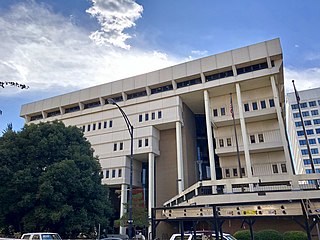
Forsyth County is located in the northwest Piedmont of the U.S. state of North Carolina. As of the 2020 census, the population was 382,590, making it the fourth-most populous county in North Carolina. Its county seat is Winston-Salem. Forsyth County is part of the Winston-Salem, NC, Metropolitan Statistical Area, which is also included in the Greensboro-Winston-Salem-High Point, NC, Combined Statistical Area. Portions of Forsyth County are in the Yadkin Valley wine region.

Old Salem is a historic district of Winston-Salem, North Carolina, United States, which was originally settled by the Moravian community in 1766. It features a living-history museum which interprets the restored Moravian community. The non-profit organization began its work in 1950, although some private residents had restored buildings earlier. As the Old Salem Historic District, it was declared a National Historic Landmark (NHL) in 1966, and expanded in 2016. The district showcases the culture of the Moravian settlement in North Carolina during the 18th and 19th centuries, communal buildings, churches, houses and shops.
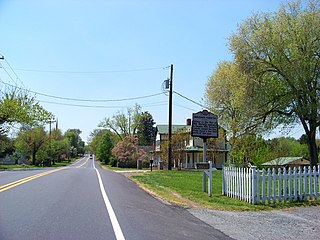
Germanton is an unincorporated community and census-designated place (CDP) in Forsyth and Stokes counties in the U.S. state of North Carolina, primarily in Stokes County. As of the 2010 census it had a population of 827.
Pine Hall is an unincorporated community in Stokes County, North Carolina, United States, approximately ten miles southwest of county seat Danbury, near Belews Lake. Danbury and Sandy Ridge are to the north, with Stokesdale to the east. Kernersville and Walkertown are to the south, with Winston-Salem to the southwest. Walnut Cove and Germanton are located to the west. On March 20, 1998, a EF-1 tornado touched down briefly in the northern part of Pine Hall, north of Route 311 near Morning Star Baptist Church. The walls were knocked from the foundation of the church and windows were blown out because of the pressure. Trees were also knocked and blown over and 3 people were injured. It was on the ground for 1.5 miles before lifting near the Stokes/Rockingham County line. This tornado and system would eventually become the Stoneville Tornado from the 1998 Gainesville-Stoneville tornado outbreak.

North Carolina Highway 8 (NC 8) is a primary state highway in the U.S. state of North Carolina. The route connects the cities of Lexington and Winston-Salem to various recreational and natural sites including Uwharrie National Forest, High Rock Lake and Hanging Rock State Park.

The Episcopal Diocese of North Carolina is a diocese of the Episcopal Church within Province IV that encompasses central North Carolina. Founded in 1817, the modern boundaries of the diocese roughly correspond to the portion of North Carolina between I-77 in the west and I-95 in the east, including the most populous area of the state. Raleigh, Charlotte, Winston-Salem, Greensboro, and Durham are the largest cities in the diocese. The diocese originally covered the entirety of the state, until the Diocese of East Carolina which stretches to the Atlantic was formed in 1883, and the Diocese of Western North Carolina which lies to the west extending into the Appalachian Mountains was formed in 1922.
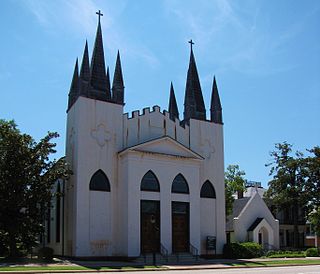
St. John's Episcopal Church in Fayetteville, North Carolina is a congregation of the Episcopal Diocese of East Carolina, a division of the Episcopal Church in the United States of America. Founded in 1817, it is located on Green Street in historic downtown Fayetteville. The congregation was formally organized April 7, 1817, and it became the first Episcopal church in the city. It is listed in the National Register of Historic Places. Public tours are available by appointment.

Chapel of the Cross is a parish of the Episcopal Church of the United States in Chapel Hill in the Diocese of North Carolina. It is the spiritual home to more than 1,600 communicants, including numerous students studying at the University of North Carolina at Chapel Hill.

The Single Brothers' House was built to house the Single Brethren, the unmarried men, of the Moravian Congregation of Salem, now Winston-Salem, North Carolina. It is part of Old Salem Museums & Gardens and open as an Old Salem tour building to visitors. It is located at 600 South Main Street, at Academy Street, on the southwest corner.
St. Michael's AnglicanChurch is a historic church and the oldest surviving religious structure in Charleston, South Carolina. It is located at Broad and Meeting streets on one of the Four Corners of Law, and represents ecclesiastical law. It was built in the 1750s by order of the South Carolina Assembly. It is listed on the National Register of Historic Places and is a National Historic Landmark.

St. Luke’s Episcopal Church is a historic Carpenter Gothic–style Episcopal church building located at 219 Chunns Cove Road, in the Chunn's Cove neighborhood of Asheville, North Carolina. Built in 1894, at a cost of $728, St. Luke’s was designed by E. J. Armstrong, a member of the congregation. Its first service was held September 17, 1894.
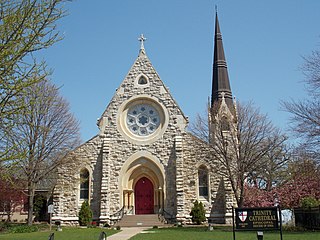
Trinity Episcopal Cathedral, formerly known as Grace Cathedral, is the historic cathedral in the Diocese of Iowa. The cathedral is located on the bluff overlooking Downtown Davenport, Iowa, United States. Completed in 1873, Trinity is one of the oldest cathedrals in the Episcopal Church in the United States. It was individually listed on the National Register of Historic Places in 1974. In 1983 the cathedral was included as a contributing property in the College Square Historic District, which is also listed on the National Register.
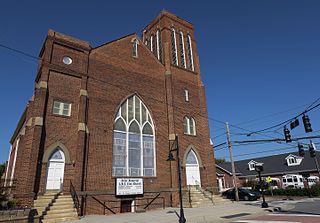
Goler Memorial African Methodist Episcopal Zion Church, also known as Old Goler, is a historic African Methodist Episcopal Zion church located at 630 Patterson Avenue in Winston-Salem, Forsyth County, North Carolina. It was built in 1918–1919, and is a rectangular brick building in the Late Gothic Revival style. It features a gable-front block flanked by two square brick towers and stained glass windows. A two-story annex was built in 1946. In 1942, the Goler Metropolitan AME Zion Church congregation split from the Goler Memorial African Methodist Episcopal Zion Church.

Goler Metropolitan AME Zion Church, originally known as East Fourth Street Baptist Church, is a historic African Methodist Episcopal Zion church located at 1435 E. Fourth Street in Winston-Salem, Forsyth County, North Carolina. It was built in 1924, and is a front-gabled brick church with two prominent domed towers and flanking one-story hipped-roof wings in the Classical Revival style. The front facade features a prominent pedimented porch supported by stuccoed Doric order columns and Ionic order pilasters. The interior is based on the Akron Plan. The building was acquired by an African-American congregation split from the Goler Memorial African Methodist Episcopal Zion Church in 1942. The congregation changed their name to Goler Metropolitan A.M.E. Zion Church in 1953.

St. Philips Moravian Church is the oldest surviving African American church building in North Carolina. The Moravian church was built in 1861 on the east side of South Church Street near Race Street in Winston-Salem, North Carolina. St Philips was enlarged in 1890 and remained in continuous use until 1952. In 2004 it was restored by Old Salem Museums & Gardens for use as an interpreted building; worship services are still held at the church on special occasions.

Saint Agnes Episcopal Church is a historic building located in Franklin, North Carolina, United States. It is a Chapel of All Saints Episcopal Church. From 1888 until 2014 St. Agnes was its own Episcopal Parish but in November of that year it officially merged with St. Cyprian's Episcopal Church to form an entirely new parish: All Saints Episcopal Church. All Saints is one congregation making use of two buildings: St. Agnes Chapel and St. Cyprian's Chapel. They use their website and Facebook to publish their worship schedule and keep parishioners and visitors up to date on where worship will be each Sunday.
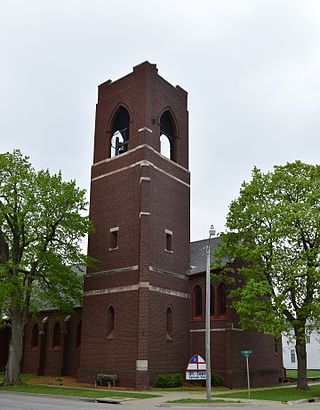
St. James Episcopal Church is a parish of the Diocese of Iowa located in Oskaloosa, Iowa, United States. It was listed on the National Register of Historic Places in 1991.

Holy Trinity Episcopal Church is an Episcopal church in the Historic District of the Fisher Park neighborhood of Greensboro, North Carolina.




















